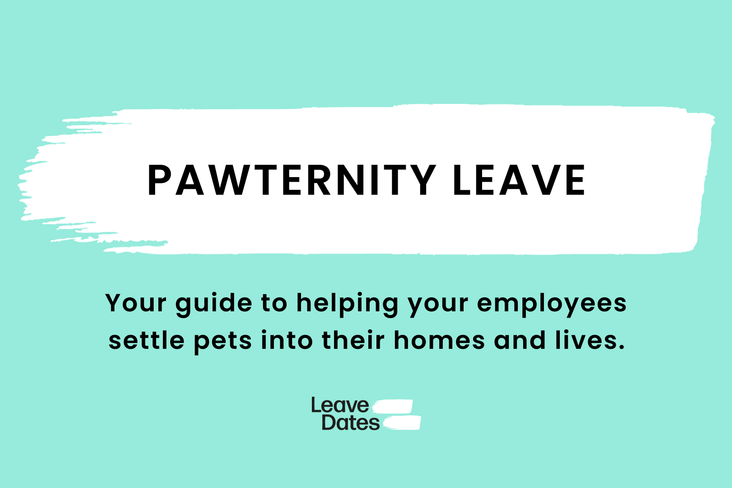Yes, you read that right. Pawternity leave – it’s fur-real. While it may sound like satire, it’s a growing trend in UK work places as more and more employers are recognising how important pets can be to people’s health and wellbeing.
As any loving pet owner will tell you, they might not be human but they are family. And just like any new family member, when a new pet arrives, it can be a life-changing (and sleep-depriving) experience.
In fact, if you’ve noticed that your Gen Z staff are more likely to be talking about their new puppy than a newborn, you’re not alone. The most recent ONS data reveals that many in this generation are opting for fur-babies instead of human ones.
We’ve all seen them, the once ironic ‘new baby’ posts on social media – complete with fake scan pictures and heartfelt captions announcing the imminent arrival of a couple’s new ‘child’ – are now mainstream. While initially a joke, these reflect a cultural shift towards treating pets as key family members.
So is pawternity leave just a meme gone wild, or a legit and reasonable thing – and something employers should be taking seriously? Should your business be offering this paw-some perk?
Table of Contents
- What is pawternity leave?
- Why pawternity leave makes purr-fect sense
- Babies are out, dogs are in
- How to implement pawternity leave
- Key takeaways
What is pawternity leave?
As you might have guessed from its not-so-subtle moniker, pawternity leave is time off (paid or unpaid) for staff who have recently brought home a pet. The aim is to give pet owners time to bond with and settle their new family member in. It’s a way to make sure everyone has enough leave to cater to all the possible ways they might choose to start a family.
While the play on words and nature of the leave suggests it’s like parental leave, it’s really just a novel – and optional – perk that companies can choose to offer to be more appealing to potential recruits in a competitive labour market. The government is yet to recognise fur babies as actual babies (we’re working on it), and so there are no rules on how long pawternity leave should be, or who is eligible.
It's not just an abstract idea, many companies in the UK currently have some kind of pawternity leave:
- BrewDog has a puppy parental leave scheme available to all staff (it’s in their name, after all!)
- Mars Petcare (makers of Whiskas and Pedigree) offers 10 hours’ paid leave to settle a new pet
- Nina Hale has ‘fur-ternity’ leave
Why pawternity leave makes purr-fect sense
While it might sound like a gimmick, pawternity leave is not a frivolity and in fact has many benefits.
Pets provide emotional support, promote physical activity and offer companionship – all of which increase overall wellbeing. In a world that is increasingly stressful and expensive, these benefits are more valuable than ever. Pets, especially dogs, encourage their owners to get outside in nature, engage in regular exercise and create routine, things that are known to benefit mental health.
What could be better than coming home to a wagging tail or purring cat after a long day at work? It’s a priceless joy (and, arguably, better than walking into a house covered in stickers, soggy snacks and playdoh… just saying!).
Lots of studies have shown that having a pet can lead to a host of health benefits. Pet owners tend to have lower blood pressure and cholesterol, and better heart health (all those walks!) and mental clarity.
For those who work long hours or in high-stress roles, these health benefits can be significant and employers can expect higher productivity and lower absenteeism due to ill health.
Overall, pets make a huge contribution to lowering stress and increasing overall health and life satisfaction. If you’re offering (or considering) health and wellbeing-related perks like gym passes, exercise classes, active travel schemes and the like, pawternity leave shouldn’t sound weird at all. It’s ticking all the same boxes and is a natural extension of physical and mental health initiatives.
Babies are out, dogs are in
In light of all the above joys, it shouldn’t surprise you that we are a nation of pet lovers. Recent stats show that 59% of households in the UK have a pet of some kind, with dogs and cats being the top choices. Over a third of UK households have a dog, with cats not far behind (just a safe distance, presumably). Over a third of UK households have a dog, with cats not far behind (just a safe distance, presumably). When you compare this with the fact that around half of women in the UK reach age 30 without having a child, the data supports the case for pawternity leave.
While pet ownership is not cost-free – and comes with its own responsibilities and expenses – it’s a heck of a lot cheaper than a baby, and (some might say) more manageable compared to raising a child.
For many, they’re the perfect pals for a fulfilling life, without the complexities (and childcare costs) that come with parenthood. Pets offer unconditional love, which can be so valuable for those living alone or going through a hard time, giving a sense of purpose and combatting loneliness.
So with their number increasing, should ‘pet parents’ get the same allowances as parents of children? After all, parental leave is a valuable benefit, equivalent to a large amount of extra paid leave that isn’t accessible to those who don’t choose to take this life path. Is that fair? Would pawternity leave, in this sense, function a bit like the ‘fresh air’ breaks taken by non-smokers who also wouldn’t mind ducking out of the office for 10 minutes?
You do have to tread carefully – eg, it would be discriminatory to offer pawternity leave to non-(human)parents only – and you don’t want to upset anyone with a policy you meant to be inclusive. So let’s have a look at how a pawternity leave policy could be applied in practice.
How to implement pawternity leave
While it’s still a pretty new concept, a growing number of companies in the UK are introducing pawternity leave to their benefits packages so there are a few examples out there to inspire you, as we saw earlier. The key steps are to:
1. Decide your policy: clearly set out what pawternity leave entails. Paid or unpaid? Hours, days or weeks? What pets count? Is it just dogs and cats, or are you covering goldfish, tamagotchis and sea monkeys (shoutout to all the ‘90s kids) too?
2. Set eligibility criteria: Who can take it? Is it a day one right, or a long-service award type perk?
3. Think about logistics: How will you manage pawternity leave alongside other types of leave? Is it going to be on top of annual leave, or will it count towards total leave? How will people ask for and book it? Will it have its own category on your leave calendar?
4. Promote it: Make sure you shout about it! This is a great opportunity to shout about how you prioritise staff wellbeing and work-life balance.
Key takeaways
Against the backdrop of a general shift towards more inclusive and flexible work policies, pawternity leave is a way to recognise the reality of modern family dynamics and the diverse lifestyles and interests of your staff. As birth rates fall and more people choose to live child-free, there is room for more innovative and quirky benefits that celebrate the richness of people’s lives and interests outside of work.
Far from mere meme fodder, pawternity leave can help your company stand out as a progressive and empathetic employer. It shows that you value your staff as whole people, not just workers, and recognising their bond with furry loved ones shows compassion and care.
In the end, whether or not you decide to adopt pawternity leave, the main thing is this: by meeting the diverse needs and interests of your staff, you can build an inclusive, supportive and happy work place. And that’s something we can all wag our tails about!





